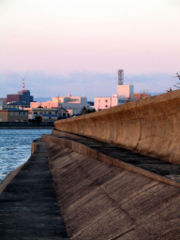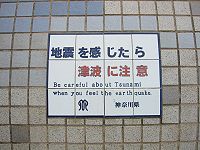Tsunami
2008/9 Schools Wikipedia Selection. Related subjects: Climate and the Weather; Natural Disasters
A tsunami (pronounced /tsuːˈnɑːmi/) is a series of waves created when a body of water, such as an ocean, is rapidly displaced. Earthquakes, mass movements above or below water, volcanic eruptions and other underwater explosions, landslides, underwater earthquakes, large meteoroid or asteroid impacts and testing with nuclear weapons at sea all have the potential to generate a tsunami. The effects of a tsunami can range from unnoticeable to devastating.
The term tsunami comes from the Japanese words (津波、つなみ) meaning harbour ("tsu", 津) and wave ("nami", 波). [a. Jap. tsunami, tunami, f. tsu harbour + nami waves. - Oxford English Dictionary]. For the plural, one can either follow ordinary English practice and add an s, or use an invariable plural as in Japanese. Tsunamis are common throughout Japanese history; approximately 195 events in Japan have been recorded.
A tsunami has a much smaller amplitude (wave height) offshore, and a very long wavelength (often hundreds of kilometers long), which is why they generally pass unnoticed at sea, forming only a passing "hump" in the ocean. Tsunamis have been historically labeled tidal waves because as they approach land, they take on the characteristics of a violent onrushing tide rather than the sort of cresting waves that are formed by wind action upon the ocean (with which people are more familiar). Since they are not actually related to tides the term is considered misleading and its usage is discouraged by oceanographers.
Causes
A tsunami can be generated when the plate boundaries abruptly deform and vertically displace the overlying water. Such large vertical movements of the Earth's crust can occur at plate boundaries. Subduction earthquakes are particularly effective in generating tsunami. Also, one tsunami in the 1940's in Hilo, Hawaii, was actually caused by an earthquake on one of the Aleutian Islands in Alaska. That earthquake was 7.8 on the Richter Scale.
Tsunami take place when a huge earthquake occurs causing the plates below the water to push up causing the water to create a huge wave.
In the 1950s it was discovered that larger tsunami than previously believed possible could be caused by landslides, explosive volcanic action, and impact events when they contact water. These phenomena rapidly displace large volumes of water, as energy from falling debris or expansion is transferred to the water into which the debris falls. Tsunami caused by these mechanisms, unlike the ocean-wide tsunami caused by some earthquakes, generally dissipate quickly and rarely affect coastlines distant from the source due to the small area of sea affected. These events can give rise to much larger local shock waves ( solitons), such as the landslide at the head of Lituya Bay which produced a water wave estimated at 50–150 m and reached 524 m up local mountains. However, an extremely large landslide could generate a " megatsunami" that might have ocean-wide impacts.
The geological record tells us that there have been massive tsunami in Earth's past.
Signs of an approaching tsunami
There is often no advance warning of an approaching tsunami. However, since earthquakes are often a cause of tsunami, an earthquake felt near a body of water may be considered an indication that a tsunami will shortly follow.
When the first part of a tsunami to reach land is a trough rather than a crest of the wave, the water along the shoreline may recede dramatically, exposing areas that are normally always submerged. This can serve as an advance warning of the approaching crest of the tsunami, although the warning arrives only a very short time before the crest, which typically arrives seconds to minutes later. In the 2004 tsunami that occurred in the Indian Ocean the sea receding was not reported on the African coast or any other western coasts it hit, when the tsunami approached from the east.
Tsunamis occur most frequently in the Pacific Ocean, but are a global phenomenon; they are possible wherever large bodies of water are found, including inland lakes, where they can be caused by landslides. Very small tsunamis, non-destructive and undetectable without specialized equipment, occur frequently as a result of minor earthquakes and other events.
Warnings and prevention

Tsunami wall at Tsu, Japan
|
A tsunami cannot be prevented or precisely predicted, but there are some warning signs of an impending tsunami, and there are many systems being developed and in use to reduce the damage from tsunami.
In instances where the leading edge of the tsunami wave is its trough, the sea will recede from the coast half of the wave's period before the wave's arrival. If the slope of the coastal seabed is shallow, this recession can exceed many hundreds of meters. People unaware of the danger may remain at the shore due to curiosity, or for collecting fish from the exposed seabed.
Regions with a high risk of tsunami may use tsunami warning systems to detect tsunami and warn the general population before the wave reaches land. In some communities on the west coast of the United States, which is prone to Pacific Ocean tsunami, warning signs advise people where to run in the event of an incoming tsunami. Computer models can roughly predict tsunami arrival and impact based on information about the event that triggered it and the shape of the seafloor ( bathymetry) and coastal land ( topography).

One of the early warnings comes from nearby animals. Many animals sense danger and flee to higher ground before the water arrives. The Lisbon quake is the first documented case of such a phenomenon in Europe. The phenomenon was also noted in Sri Lanka in the 2004 Indian Ocean earthquake. Some scientists speculate that animals may have an ability to sense subsonic Rayleigh waves from an earthquake minutes or hours before a tsunami strikes shore (Kenneally, ). More likely, though, is that the certain large animals (e.g., elephants) heard the sounds of the tsunami as it approached the coast. The elephants reactions were to go in the direction opposite of the noise, and thus go inland. Humans, on the other hand, head down to the shore to investigate.
While it is not possible to prevent a tsunami, in some particularly tsunami-prone countries some measures have been taken to reduce the damage caused on shore. Japan has implemented an extensive programme of building tsunami walls of up to 4.5 m (13.5 ft) high in front of populated coastal areas. Other localities have built floodgates and channels to redirect the water from incoming tsunami. However, their effectiveness has been questioned, as tsunami are often higher than the barriers. For instance, the Okushiri, Hokkaidō tsunami which struck Okushiri Island of Hokkaidō within two to five minutes of the earthquake on July 12, 1993 created waves as much as 30 m (100 ft) tall - as high as a 10-story building. The port town of Aonae was completely surrounded by a tsunami wall, but the waves washed right over the wall and destroyed all the wood-framed structures in the area. The wall may have succeeded in slowing down and moderating the height of the tsunami, but it did not prevent major destruction and loss of life.
The effects of a tsunami can be mitigated by natural factors such as tree cover on the shoreline. Some locations in the path of the 2004 Indian Ocean tsunami escaped almost unscathed as a result of the tsunami's energy being sapped by a belt of trees such as coconut palms and mangroves. In one striking example, the village of Naluvedapathy in India's Tamil Nadu region suffered minimal damage and few deaths as the wave broke up on a forest of 80,244 trees planted along the shoreline in 2002 in a bid to enter the Guinness Book of Records. Environmentalists have suggested tree planting along stretches of seacoast which are prone to tsunami risks. While it would take some years for the trees to grow to a useful size, such plantations could offer a much cheaper and longer-lasting means of tsunami mitigation than the costly and environmentally destructive method of erecting artificial barriers.
Tsunami in History
Historically speaking, tsunami are not rare, with at least 25 tsunami occurring in the last century. Of these, many were recorded in the Asia-Pacific region - particularly Japan. The Boxing Day Tsunami on Boxing Day 2004, caused approx. 230,000 deaths and many more injuries. The destruction of the Egyptian city of Alexandria in A.D.365 is now presumed to have been caused by a tsunami.



